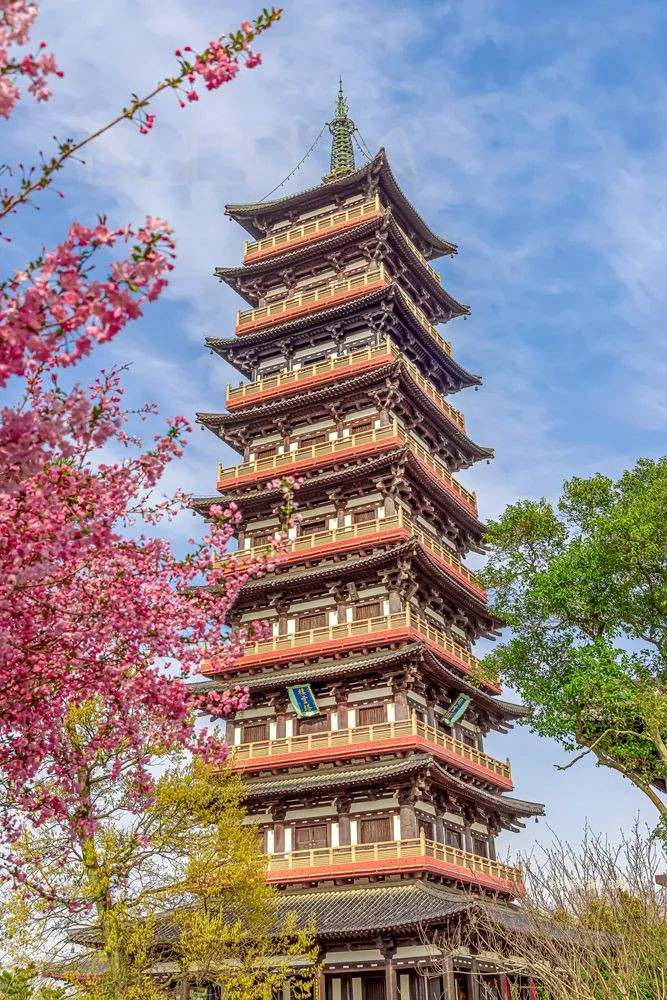Chinese style? Japanese style? Daming Temple
Entering the Daming Temple in Yangzhou
It's like crossing from Jiangnan and Yangzhou to another world
It feels a bit unfamiliar yet familiar
The architectural style of those pagoda buildings, the dry landscape
It always feels a bit like walking into a Japanese temple
But winding pavilions, fluttering palace lanterns in the wind
But it brings you back to the ancient Chinese style

Daming Temple was named after its initial construction during the reign of Emperor Xiaowu of the Southern Song Dynasty (457-464 AD). For over 1500 years, the names of temples have undergone many changes, such as being called "Qiling Temple" and "West Temple" during the Sui Dynasty, and "Chengping" during the late Tang Dynasty. In the Qing Dynasty, due to the taboo of the two characters "Daming", it was once referred to as "Qiling Temple". In the 30th year of the Qianlong reign, the emperor personally inscribed the "Imperial Edict for Fajing Temple". In 1980, Daming Temple was restored to its original name.
In the first year of the Renshou reign of the Sui Dynasty (601 AD), Emperor Yang Jian issued an edict to celebrate his birthday by building 30 pagodas throughout the country to support Buddhist bones. The temple was built with the "Qiling Pagoda", which was nine stories high and magnificent, and was known as the "most majestic and unique in China". Therefore, the temple is also known as the "Qiling Temple". Master Jianzhen of the Tang Dynasty served as the abbot of Daming Temple, making it an important ancient temple in the history of Sino Japanese Buddhist cultural relics relations. In the third year of Tang Huichang (843 AD), the nine story Qiling Pagoda was destroyed by a great fire. Later, the monks raised funds for reconstruction, but it was repeatedly abandoned.
In 1963, to celebrate the 1200th anniversary of the passing of the Tang Dynasty's Dajianzhen, a grand commemorative event was held, which was reorganized and renovated. In 1979, the temple underwent comprehensive repairs, with the Buddha statues gilded and the Daming Temple rejuvenated.
In 1980, in order to welcome the return of the statue of Master Jianzhen to China for exhibition, it was renamed "Daming Temple".


During the era in which Jianzhen lived, cultural exchanges between China and foreign countries were frequent, especially in Japan, which was only a strip of water away. They constantly sent envoys and students to Chang'an to study and absorb the culture of the Tang Dynasty. Jianzhen resolutely made a vow to go to Japan with the spirit of dedication of "why sacrifice his life for the sake of the law", and successfully crossed the sea for the sixth time in the twelfth year of Tang Tianbao (753). Jianzhen lived in Japan for 10 years and passed away due to illness in Nara, Japan in the first year of Tang Guangde (763) at the age of 76.
During his 10 years in Japan, he established Vinaya and corrected the Tripitaka. In addition, medical knowledge was introduced to the Japanese people, and scientific technologies such as Buddhism, linguistics, literature, architecture, sculpture, calligraphy, and printing were exchanged, promoting the development of Japanese culture
In fact, the Japanese style that we are familiar with is more of the Chinese style from the past.





The most distinctive building of Daming Temple is the Jianzhen Memorial Hall. The memorial hall was built in 1973 to commemorate the 1200th anniversary of the passing of Master Jianzhen, as instructed by Premier Zhou Enlai.
Before Jianzhen crossed over to Japan, he was the abbot of Daming Temple. Starting from the first year of the Tianbao reign of the Tang Dynasty (742 AD), after more than ten years of hardships, the successful sixth eastward migration introduced Chinese Buddhism, medicine, language and literature, architecture, sculpture, calligraphy, printing, etc. to Japan, making important contributions to the development of cultural exchanges between China and Japan.
In 1922, Japanese scholar Daiding Changpan erected a monument in front of the temple to commemorate the remains of Tang Jianzhen, a monk. It is modeled after the Tang Dynasty Temple in Nara, Japan, designed by architect Mr. Liang Sicheng. It consists of three parts: a pavilion, a long corridor, and a memorial hall, with a total area of 700 square meters















So you can find a different Yangzhou at Daming Temple.
Previous Article:Fireworks in March in Yangzhou, a must visit to Shouxi Lake in Yangzhou
Next Article:The city with the most culinary culture: even more refined than Wuhan, with cuisine included in state banquets
